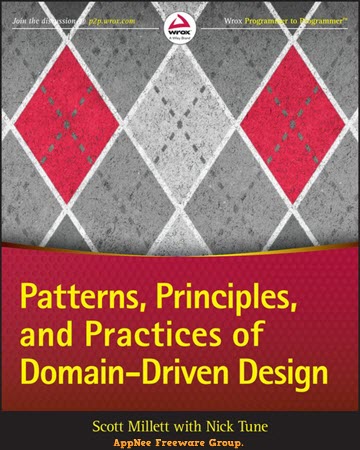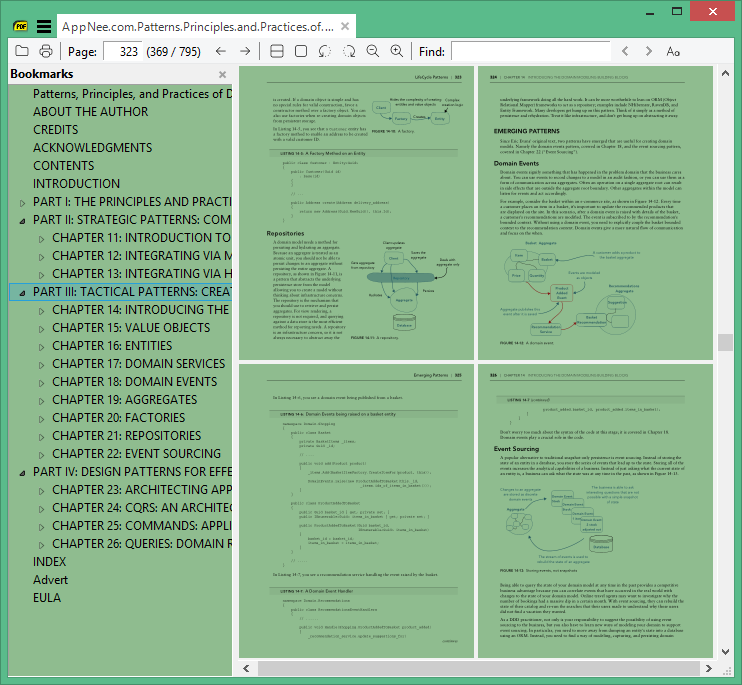| Ⅰ | This article along with all titles and tags are the original content of AppNee. All rights reserved. To repost or reproduce, you must add an explicit footnote along with the URL to this article! |
| Ⅱ | Any manual or automated whole-website collecting/crawling behaviors are strictly prohibited. |
| Ⅲ | Any resources shared on AppNee are limited to personal study and research only, any form of commercial behaviors are strictly prohibited. Otherwise, you may receive a variety of copyright complaints and have to deal with them by yourself. |
| Ⅳ | Before using (especially downloading) any resources shared by AppNee, please first go to read our F.A.Q. page more or less. Otherwise, please bear all the consequences by yourself. |
| This work is licensed under a Creative Commons Attribution-NonCommercial-ShareAlike 4.0 International License. |

Domain-driven design (DDD) is the process of keeping your code aligned with the problem domain. As your product evolves, adding new features will be more difficult than it was during the brand-new phase of development. With a better understanding of the problem domain and collaboration with the business, developers are more likely to build software that is easier to read and easier to adapt to future functional extensions.
Patterns, Principles, and Practices of Domain-Driven Design focuses on introducing the principles and practices of breaking down complex problem spaces, as well as the implementation patterns and best practices that form the maintainable solution spaces. The book is divided into four parts: 1) Mainly introduces the ideological systems, principles and practices of DDD; 2) Details the tactical modes of integrating bounded context; 3) Introduces the strategic patterns for creating effective domain models; 4) Delves into the design patterns you can apply to leverage domain models and build effective applications.
This book provides complete and interlinked coding examples that reveal techniques for integrating decomposed and distributed solution spaces. At the same time, the coding of best practices and patterns will give you advice on how to build applications that are maintainable and extensible. After finishing this book, you will have a comprehensive understanding of DDD, be able to articulate its value and when to use it, and be ready to construct and maintain complex software management for large, complex problem domains.
Compared with the classic Domain-Driven Design written by Eric Evans, Patterns, Principles, and Practices of Domain-Driven Design is easier to understand and more rich in content. It contains a lot of contents that are not included in Domain-Driven Design, such as CQRS architecture, event traceability, etc. But it is not a replacement for the former. It is recommended that you read this book first, then read Domain-Driven Design and Vaughn Vernon’s Implementing Domain-Driven Design, so that developers can quickly understand the ideological system before going further into its subject matter.

// Table Of Contents //
- Part I: The Principles and Practices of Domain-Driven Design
- Chapter 1: What Is Domain-Driven Design?
- Chapter 2: Distilling the Problem Domain
- Chapter 3: Focusing on the Core Domain
- Chapter 4: Model-Driven Design
- Chapter 5: Domain Model Implementation Patterns
- Chapter 6: Maintaining the Integrity of Domain Models with Bounded Contexts
- Chapter 7: Context Mapping
- Chapter 8: Application Architecture
- Chapter 9: Common Problems for Teams Starting Out with Domain-Driven Design
- Chapter 10: Applying the Principles, Practices, and Patterns of DDD
- Part II: Strategic Patterns: Communicating Between Bounded Contexts
- Chapter 11: Introduction to Bounded Context Integration
- Chapter 12: Integrating via Messaging
- Chapter 13: Integrating via HTTP with RPC and REST
- Part III: Tactical Patterns: Creating Effective Domain Models
- Chapter 14: Introducing the Domain Modeling Building Blocks
- Chapter 15: Value Objects
- Chapter 16: Entities
- Chapter 17: Domain Services
- Chapter 18: Domain Events
- Chapter 19: Aggregates
- Chapter 20: Factories
- Chapter 21: Repositories
- Chapter 22: Event Sourcing
- Part IV: Design Patterns for Effective Applications
- Chapter 23: Architecting Application User Interfaces
- Chapter 24: CQRS: An Architecture of a Bounded Context
- Chapter 25: Commands: Application Service Patterns for Processing Business Use Cases
- Chapter 26: Queries: Domain Reporting
// Book Example Codes //
// Download URLs //
| Format | Download | Size |
 |
23.1 MB |
(Homepage)
| If some download link is missing, and you do need it, just please send an email (along with post link and missing link) to remind us to reupload the missing file for you. And, give us some time to respond. | |
| If there is a password for an archive, it should be "appnee.com". | |
| Most of the reserved downloads (including the 32-bit version) can be requested to reupload via email. |